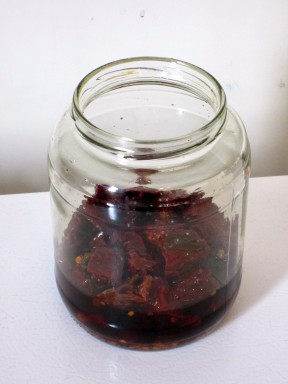As I mentioned recently, I’ve been making a conscious effort to branch out and brew some less traditional beers lately. This pair of porters is a good example. The base recipe is the same for both, but one has a substantial portion (30%) of the grist replaced with Briess Cherrywood Smoked Malt, and the other was aged on chipotle peppers post-fermentation.
For starters, a double brew session without a shared mash and/or boil makes for a long day. I mashed in the first beer right at sunrise (9:30 AM) and wasn’t finished cleaning until after 6 PM. So if I try that again it will be on a much warmer day.
Anyway, on to the beers. They’re both good. Unfortunately, the cherrywood malt is quite a bit milder than its beechwood cousin, so while the balance was superb to begin with, after two months it’s fallen off to the point that it’s barely noticeable. In a beer with as much going on as this, I think a better guideline might be around 50% with a short aging period to allow for mellowing of the phenols, or 30-40% in a beer that’s destined to be drunk more quickly. I’m going to be brewing a lager using my remaining store of this malt, and it will be interesting to see how it holds up in a more straightforward grain bill.I’m a bit happier with the chipotle porter, although it too has become a bit less balanced with age. In this case, the roasted malt character of the base beer has fallen off, increasing the perceived piquancy over time. On that subject, I should probably point out that I have a capsaicin tolerance higher than most, and also have the smoked porter available for blending. While 2.0 oz of peppers worked well for me, you might want to use less. On the other hand, the Scoville rating of chipotles varies widely, so comparisons from one lot to the next are more or less irrelevant. As when cooking with chiles, experience should be your guide.
The peppers should be naturally abiotic, and I imagine that the smoking only helps in that regard. I didn’t want to take any chances, so I coarsely chopped the chipotles and steeped them in just enough vodka to cover them. After a few days I dumped the whole mess into the fermenter, just about the time fermentation was winding down, and left them in contact with the beer for a week. In other words, I “dry-peppered” the beer. I don’t have a baseline for comparison, but the finished beer does have a wonderful chipotle aroma, so I’ll probably stick with this technique going forward.
Smoke in the Porter recipe (PDF)
Fire on the Side recipe (PDF)


Leave a Reply